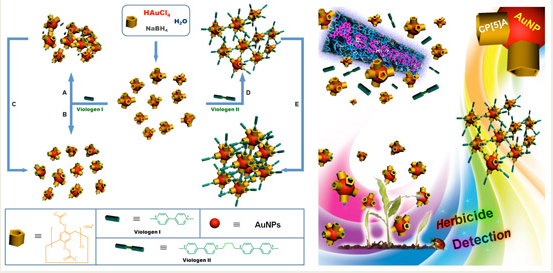
Pillar[n]arenes (P[n]A), are a relatively new class of supramolecular hosts, and have received considerable attention for their novel symmetric pillar-shaped architectures, unique host-guest properties, and highly tunable functionality. Recently, Ying-Wei Yang’s Research Group successfully fabricated supramolecular hybrid nanomaterials by combing them with Au nanoparticles (AuNPs). The hybrid nanomaterials significantly combines and enhances the characteristics of the two entities, such as the electronic, heating, and catalytic properties of AuNPs and molecular recognition of P[n]A. They found that Carboxylatopillar[5]arene (CP[5]A) can be employed as a stabilizing ligand for in situ preparation of AuNPs and CP[5]A-modified AuNPs with good dispersion and narrow size distributions. Interestingly, guest molecules can induce one-dimensional, two-dimensional and three-dimensional assembly of CP[5]A-modified AuNPs, indicating that the AuNP-immobilized CP[5]As still possess good host-guest properties. More importantly, CP[5]A-modified AuNPs can also be used as optical probes for herbicide detection. The work just published in the Journal of the American Chemical Society (J. Am. Chem. Soc. 2013, 135, 1570-1576). SERS-based nanosensors utilizing the above CP[n]A-modified AuNPs, with enhanced selectivity and sensitivity, are currently under construction in the Yang laboratory.